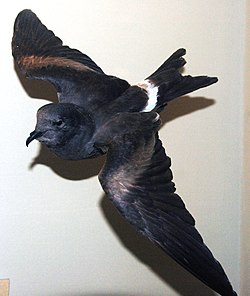Guadalupe-Wellenläufer
| Guadalupe-Wellenläufer | ||||||||||
|---|---|---|---|---|---|---|---|---|---|---|
 Guadalupe-Wellenläufer (Hydrobates macrodactylus) | ||||||||||
| Systematik | ||||||||||
| ||||||||||
| Wissenschaftlicher Name | ||||||||||
| Hydrobates macrodactylus | ||||||||||
| (Bryant, 1887) |
Der Guadalupe-Wellenläufer (Hydrobates macrodactylus, Syn.: Oceanodroma macrodactyla), auch als Guadalupe-Sturmschwalbe bezeichnet, ist ein möglicherweise ausgestorbener Seevogel aus der Familie der Wellenläufer (Hydrobatidae). Er ist oder war endemisch auf der mexikanischen Pazifikinsel Guadalupe.
Beschreibung

Der Guadalupe-Wellenläufer erreicht eine Länge von 23 Zentimetern. Er sieht dem Wellenläufer (Oceanodroma leucorhoa) sehr ähnlich, der ebenfalls auf Guadalupe brütet. Er hat aber hellere Unterflügeldecken. Der Schnabel ist zudem breiter und tiefer an der Basis. Die Oberseite ist schieferschwarz. Der Bürzel ist weiß. Die Flügeldecken sind gräulich braun. Die Federn weisen breite dunkle Spitzen auf. Die Oberschwanzdecken und die Unterflügeldecken sind weiß. Der Schwanz ist tief gegabelt.
Lebensweise
Der Guadalupe-Wellenläufer nistet hauptsächlich im März. Brütende Vögel wurden jedoch auch im Mai oder Juni beobachtet. Das Gelege, das sich häufig unter Kiefern befindet, besteht aus einem einzigen Ei. Es ist weiß und zeigt braune oder lavendelfarbene Flecken. Es wird in ein mit Zweigen und Kiefernnadeln gepolstertes Erdloch gelegt. Über die Lebensweise und Wanderungen des Guadalupe-Wellenläufers außerhalb der Brutsaison ist nichts bekannt.
Status
Trotz intensiver Nachforschungen hat es seit 1912 keine zuverlässigen Nachweise mehr über die Art gegeben. Suchen in den Jahren 1922, 1925 und in den 1970er-Jahren schlugen ebenso fehl wie die erste Expedition während einer Brutsaison im Jahre 2000. Als ein Team des San Diego Natural History Museum im Juni 2000 Guadalupe besuchte, fanden sie nur Exemplare des Wellenläufers vor.
Der Rückgang des Guadalupe-Wellenläufers begann mit der Invasion von Ziegen und Katzen auf Guadalupe im späten 19. Jahrhundert. Über 50.000 Ziegen zerstörten die Vegetation und zertrampelten die Eier. Die Katzen stellten den Küken nach.
Literatur
- Dieter Luther (1986): Die ausgestorbenen Vögel der Welt Westarp-Wissenschaften, Magdeburg; Spektrum, Heidelberg. ISBN 3-89432-213-6
- Michael Brooke (2004): Albatrosses and Petrels Across the World. Oxford University Press. ISBN 0-19-850125-0
- James C. Greenway (1967): Extinct and Vanishing Birds of the World. Dover Publications Inc., New York, ISBN 0-486-21869-4
- Charles Carboneras (1992): Family Hydrobatidae (Storm-petrels). In: del Hoyo, Josep; Elliott, Andrew und Sargatal, Jordi (Hrsg.): Handbook of Birds of the World (Volume 1: Ostrich to Ducks): S. 258–271. Lynx Edicions, Barcelona. ISBN 84-87334-10-5
- Kaeding, Henry B. (1905): Birds from the West Coast of Lower California and Adjacent Islands. Condor 7 (4): 105–111. PDF Volltext
- Thayer, John E. & Bangs, Outram (1908): The Present State of the Ornis of Guadaloupe Island. Condor 10 (3): 101–106. doi:10.2307/1360977 PDF Volltext
- Townsend, Charles Haskins (1923): Birds collected in Lower California. Bulletin of the American Museum of Natural History 48: 1–25. PDF Volltext
Weblinks
- Hydrobates macrodactylus in der Roten Liste gefährdeter Arten der IUCN 2018.2. Eingestellt von: BirdLife International, 2018. Abgerufen am 9. Februar 2019.
Auf dieser Seite verwendete Medien
Autor/Urheber: James St. John, Lizenz: CC BY 2.0
Oceanodroma macrodactyla Bryant, 1887 - male Guadalupe petrel (mount, FMNH 33449, Field Museum of Natural History, Chicago, Illinois, USA).
The procellariiform birds are the albatrosses and petrels, seabirds that are frequently over the open-ocean. The Guadalupe petrel is a recently-extinct bird wiped out by human-introduced cats onto Guadalupe Island, a couple hundred miles offshore from the western shore of Baja California, Mexico. The island was the species’ only nesting locality. Petrels are principally oceanic piscivores (fish eaters), but also feed on small nekto-planktonic marine arthropods.
Classification: Animalia, Chordata, Vertebrata, Aves, Procellariiformes, Hydrobatidae
Birds are small to large, warm-blooded, egg-laying, feathered, bipedal vertebrates capable of powered flight (although some are secondarily flightless). Many scientists characterize birds as dinosaurs, but this is consequence of the physical structure of evolutionary diagrams. Birds aren’t dinosaurs. They’re birds. The logic & rationale that some use to justify statements such as “birds are dinosaurs” is the same logic & rationale that results in saying “vertebrates are echinoderms”. Well, no one says the latter. No one should say the former, either.
However, birds are evolutionarily derived from theropod dinosaurs. Birds first appeared in the Triassic or Jurassic, depending on which avian paleontologist you ask. They inhabit a wide variety of terrestrial and surface marine environments, and exhibit considerable variation in behaviors and diets.
